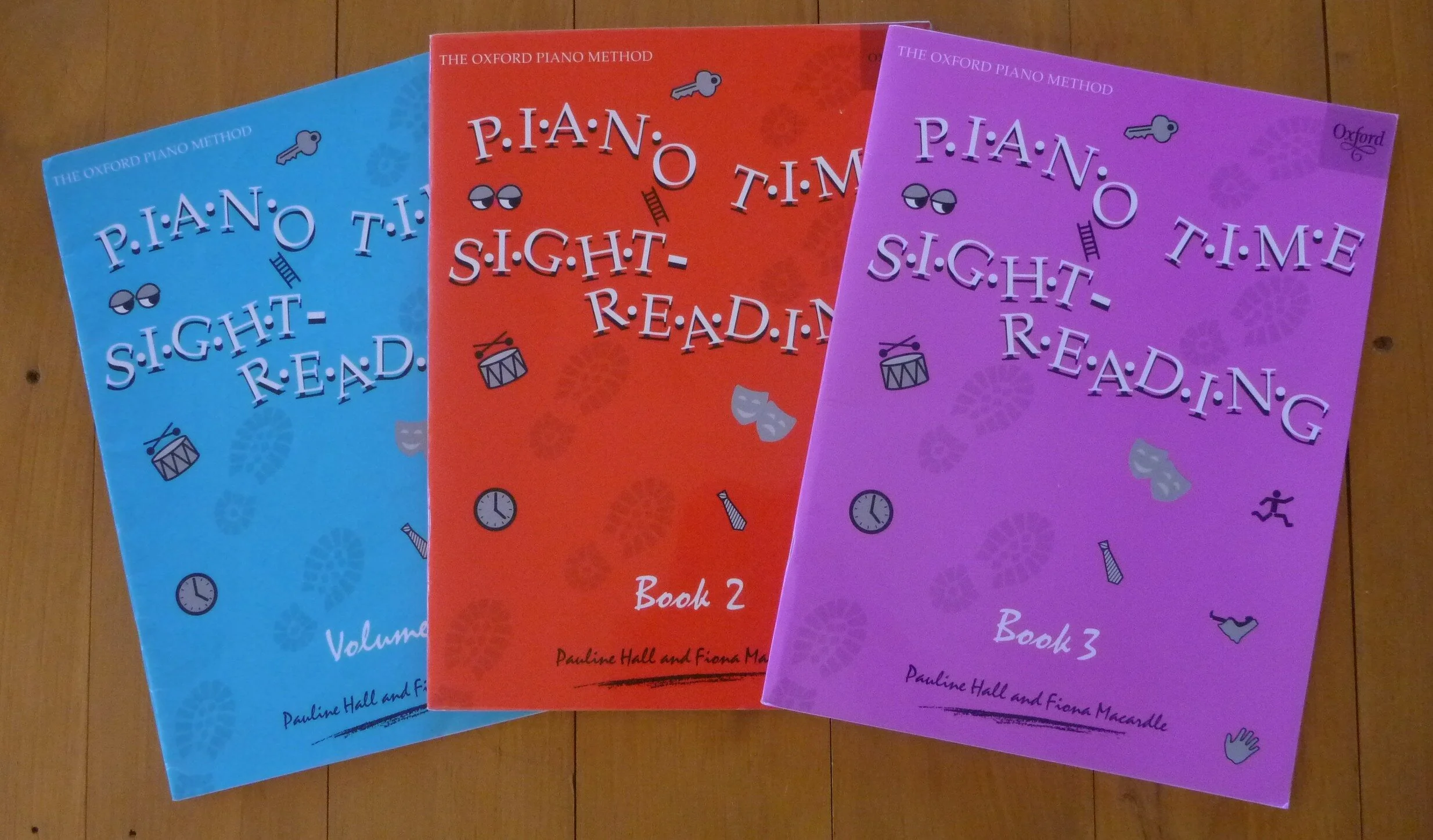There are three books in this series and they were published in 1996 by Oxford University Press. Even considering that these books are now 24 years old, the illustrations in the books and on the cover, along with the presentation of the books does not appear dated at all. The illustrations in other books in the Piano Time series are always fun, albeit a little quirky in character.
The description when selling these books discussed that they are ‘designed to build confidence and ability, the Piano Time Sight-Reading books are enormous fun, interspersing lots of short, structural exercises with puzzles and games. The material is simple, imaginative and clearly laid out’.
And, according to the advertising material, ‘Book 1 presents lots of short tunes in five-finger position, which are mostly hands separately. Book 2 contains short exercises in five-finger positions, it introduces accidentals and examples where the hands are played together’. Book 3 is made up of short exercises using hands playing together, there are changes of hand position and there are varied time signatures, styles and dynamics’.
These books, to a certain extent follow the ABRSM sight- reading books, so for example it would be a good idea to use Book 1 whilst a pupil is preparing for the Grade 1 practical exam.
Book 1 - there is an introduction in this book that asks the question - do you want to be an explorer? It states that it is a dangerous journey, although to be honest, I wonder if this is the message one is wishing to convey to a pupil when encouraging them to work on their sight-reading in the lesson and at home. However, in carrying on, it states that there are going to be secret code-signs which tell what to look out for. Once the pupil gets used to using these secret code-signs will result in their checking of the music before playing and as a result, the reading of new pieces becomes easier and more fun. Lastly, it is suggested that the pupil does not rush through the whole book, instead it is recommended that one or two tunes should be played each day. Also, it advocates going back to some of the previous exercises at various stages and this will mean that they will be easier the second time around.
And of course, there are the Golden Rules for sight-reading which are counting and maintaining the beat as well as always looking ahead and not going back to correct any ‘mistakes’.
Here are my observations about Book 1.
the tie is introduced right at the beginning which in my opinion seems a little early in the progression.
initially repeated notes and seconds are used in the melodies.
after this, thirds are introduced.
in some cases the pupil will require reinforcement of these concepts by using other sight-reading material and then returning to this book.
next, quavers are introduced.
there are a number of games and puzzles throughout the book and many are unique and thought-provoking.
there is good advice in regards to using a long note to look ahead.
the dotted crotchet/quaver pattern is introduced, following this dynamics covering pp to ff, as well as crescendo and diminuendo signs and rests.
some pupils may find the examples with a rest on the first beat of the bar a little unsettling.
there is constant reference to the need to prepare when playing sight-reading examples.
Here are my observations about Book 2.
there is revision at the start of this book covering the concepts learnt in Book 1. As advised before, the use of supplementary material will be beneficial for most pupils when using these books.
there are a few examples that seem to have been composed purely for the reinforcement of encountering rests in a sight-reading example. I feel that it would be better to let a pupil come across rests in their sight-reading examples in a more musical setting so to speak.
accidentals and the use of ledger lines are introduced.
later on in the book the pupil will need to start playing with hands together. However, the exercises stay within a five-finger position.
the time signatures used in the book are all in simple time, simple duple, triple and quadruple.
there are virtually no games or puzzles present in Book 2.
Here are my observations about Book 3.
a wider range of time signatures are employed in Book 3.
there are some games and puzzles present however there are fewer in Book 3 than there are in Book 1.
far fewer secret code-signs are present in Book 3 and the pupil is encouraged to take more initiative in working out what is required when playing the examples.
there are some quite complex rhythmic patterns used in some of the examples.
larger intervals are employed.
the hands start to move out of a five-finger position and the fingering that is inserted gives the clue to the player that their hand has to move to a new position.
phrasing, imitation and interplay between the hands are concepts that are introduced.








